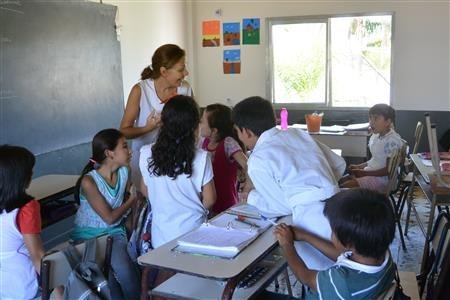 |
| Anusia interacting with her students.(Photo by Annie Merkley) |
How far would you travel for work? Grueling commutes are common the world over, however some are treks of devotion and dedication rather than sheer necessity.
Anusia Kaczorkiewicz wakes up before the sun to prepare food, coffee and tea for her long journey to teach English. The schools in the River Delta Paraná in Argentina where she works take up to four hours one way to reach from her home in Olivos—a northern suburb of Buenos Aires. She heads out the door with the first hints of dawn, morning birds chirping as the dark of night lessens its hold on the light.
Kaczorkiewicz walks a few blocks to a bus stop, and commences her journey with an hour ride to Tigre—the delta port town where the bustling fluvial (boat) station is located. In the early morning light, teachers, students and residents line up as the lanchas (water school buses and taxis) maneuver the brown waters with a choreographed grace.
The wooden lanchas are laden with passengers as the engines hum; students play games as the teachers communally share mate (traditional Argentine tea) and socialize. The female students wear white pinafores over their street clothes and the boys wear white over-jackets that resemble lab coats. The teachers also adorn similar uniforms.
It’s a slow expedition crossing many rivers. The ochre brown waters churn behind the lancha and the reeds sway in the wake, dogs come out to the home’s boat landings to bark as the lancha slows to pick up students or to deliver mail.
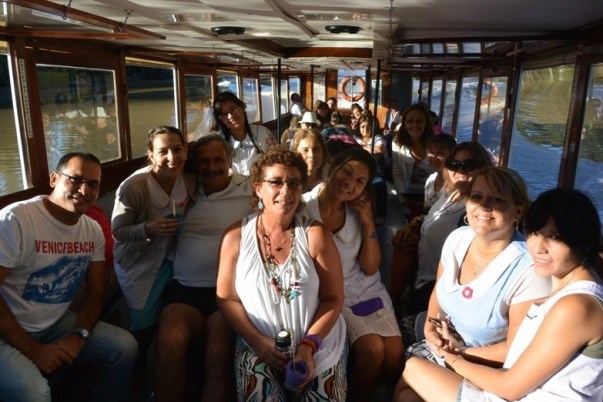 |
| Teachers on the lancha on the way to work, with principal of school 26, Marcelo Lauritto on the left in a Venice Beach t-shirt (Photo by Annie Merkley) |
Kaczorkiewicz smiles and tilts her head back in an enchanted state, saying how much she loves the smell of the trees, flowers and river—bliss radiating off of her. The boat slowly empties, and after over 3 hours on the lancha we reach our remote destination of Primary School 16. This semester she divides her time between 4 different schools of varying distances.
When asked why she travels so far to teach, she replied with earnest care, “Because I think these kids don’t have the same opportunities kids from city areas have…One thing that I have is that we did not choose where we were born. So if you had had more possibilities in life because life has been generous with you and you were brought up in a house where education was important, you had the opportunity to learn a language, you had the opportunity to travel; I think that you have to give back something of all that for others to enjoy.”
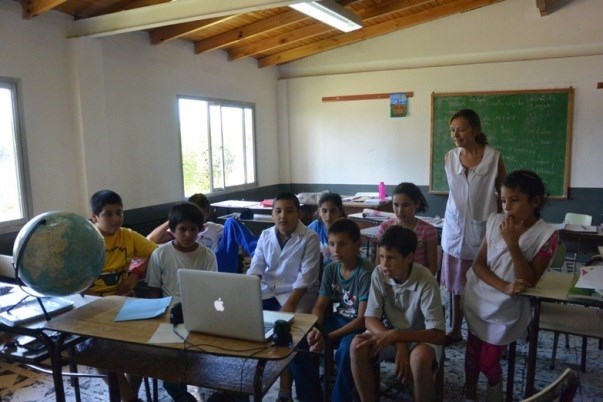 |
| Anusia with students watching Biblioburro short documentary from The MY HERO Project (Photo by Annie Merkley) |
The students at primary school 16 are so isolated; many have never even visited Buenos Aires. Kaczorkiewicz said, “Because they don’t travel often, I need to open the world for them...They need to know that people from other countries are also friends, that there are good people in other parts of the world too. And they need to know how important speaking English is.”
With English, Kaczorkiewicz uses the platform of teaching a new language to cover a multitude of topics, “You can do what ever you want with English. Take it to the literature field; take it to the science or social field. And at the same time you start giving them the basic tools that they need to communicate.” She continued with a grin ear to ear, and raised her hand for emphasis, “But having fun. You can learn having fun. And you learn best if you have fun. All these things bring magic!”
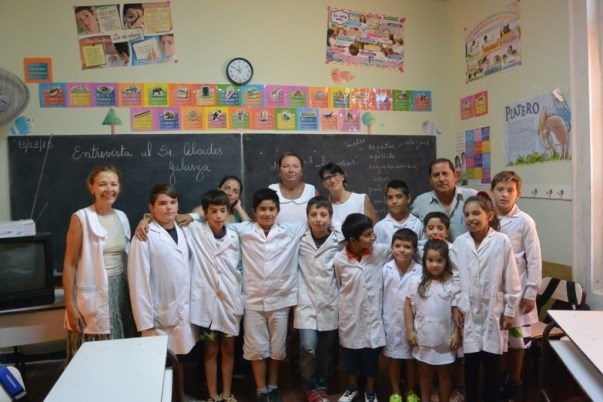 |
| Students and staff of Isla Martín García with Anusia on the left, principal Rosana Paoletta in the center and community hero, Alcidez Galarza on the right (Photo by Annie Merkley) |
She has introduced iEARN (an international cultural exchange that connects classrooms across the globe to enhance understanding and empathy for students living in extraordinarily diverse environments) and Trendy Teddies Traveling (a project affiliated with iEARN where teddy bears are taken home by students in other countries and sent back with a diary and photos). Kaczorkiewicz has also utilized her English classes to teach her students to care for their environment. By sampling the water from different rivers in the delta to creating a short video with her students from school 26 about respecting the delicate balance of nature in the area. She is aiding in the preservation of a UNESCO declared reserve and biosphere, the Paraná Delta.
Even after 20 years of teaching Kaczorkiewicz is passionate about always trying new activities to get her students thinking about grander ideas. With the introduction of the MY HERO Project she had her classes ponder the definition of a hero. Discussing how heroes are real life people and not comic book characters with capes. She then invited local community heroes to be interviewed by the students.
Each of the schools are individually overseen. The schools are very grassroots organized to construct, maintain, and repair from the common flood damage. The unfortunate fact is that funds for public schools are sparse in Argentina.
Each of the community heroes have lent helping hands and committed much of their lives to looking after the schools and surrounding nature.
At school 26 the students interviewed Grannie Elsa Ensunza, whose family donated the land for the school to be built on and has had constant care for the school. You can see the appreciation as the whitewashed school with blue trim (which is common aesthetics in the delta) is clean, organized and a nurturing learning environment. Grannie Elsa runs a little snack shop during recess as a special treat to the kids and is often seen picking up trash caring for the grounds as if an extension of her own home.
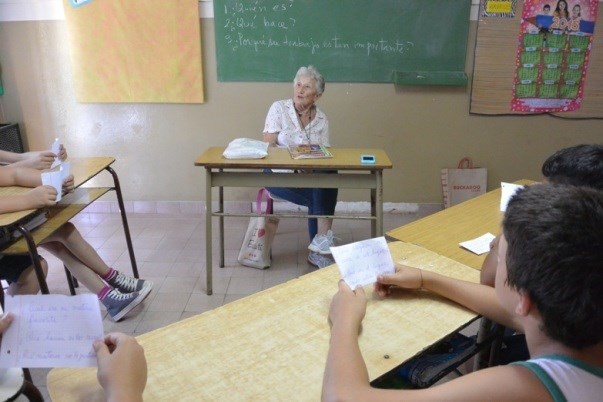 |
| Students interviewing community hero Grannie Elsa Ensunza at school 26 (Photo by Annie Merkley) |
At school 16 the students interviewed Roxana Bogao who was a student of the school decades ago and a member of the community who offered her free time to help however she could. School 16 also has a wonderful "comedor" (dining hall) that the community came together to build after the basement cafeteria had been destroyed during a flood. Blanca Sampietro and Gladys Pinazo who have worked at the school for years were paramount in helping with the new "comedor."
And, at the beautiful dark wooden school in Isla Martín García (that just celebrated it's 125th anniversary) the community hero interviewed was Alcidez Galarza. The children sat in a circle and asked such thoughtful questions filled with reverence for a man who has spent his life tending to the island. Isla Martín García is a nature and wildlife reserve unto itself and is an exceptionally stunning part of the delta-with only 123 inhabitants the school's students and staff consists of fewer than 20 in total. It is an intimate and gracious environment.
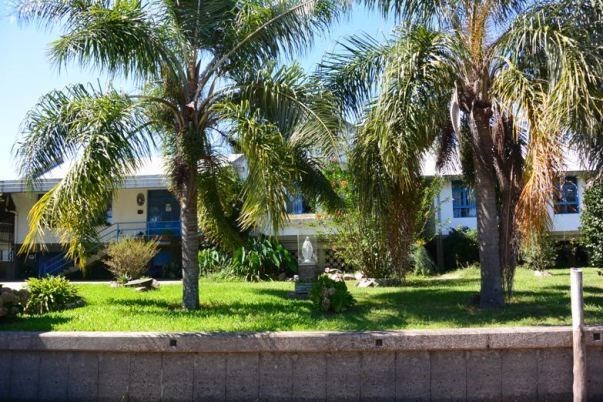
Even though Kaczorkiewicz's title is English Professor, her role in inspiring positive change in the students and schools is astounding. She brings so much more to the table than just teaching English.
A student of hers for 4 years starting from '95, Ezequiel Pavon, said that he remembers Kaczorkiewicz full of energy, with such a beautiful disposition and always positive. He recalls clearly all these years later that during his English classes with her, she would always ask questions that made him reflect and contemplate internally. He said that what she taught him has always stayed with him in his life.
Kaczorkiewicz is not alone in making the massive treks to these remote schools. Dozens of dedicated teachers and principals make the same remarkable journey to educate the children of these outlying areas. Many could work in Buenos Aires, have less of a commute and earn more money. But their affection for the students of the delta lures them in.
Both principals of Martín García, Rosana Paoletta, and of School 26, Marcelo Lauritto, believe the biggest problem that faces the students is the inaccessibility to medical care in case of emergencies. Both Paoletta and García love their jobs immensely the smiles on their faces as they spoke of their students was one of joy and appreciation.
As I sat on the boat landing of school 16 with Kaczorkiewicz sharing a mate with her during our interview, I became hugely emotional and humbled. I had been introduced to the astounding life on the delta, one filled with verdant swaying trees and communities living so rurally and in harmony with the rippling river. I was fortunate enough to speak to the students and share with them my life’s story, with the use of a globe and pictures I shared with them the many places I have visited. Many of the student’s had never met a person from outside of Argentina before and I felt incredibly fortunate to share laughter with these amazing children and answer their inquisitive questions.
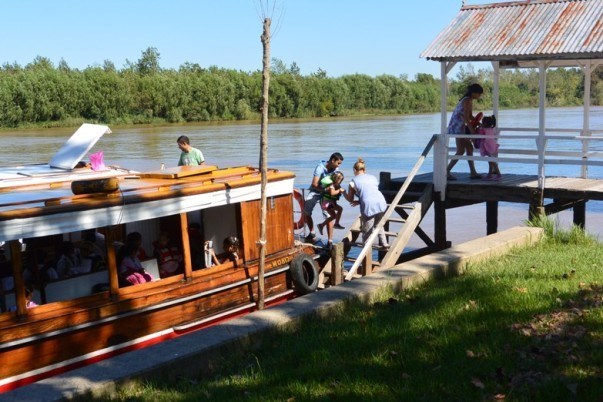
Kaczorkiewicz welcomed me into her home, sharing food and stories with me. She went out of her way to help me get to know the schools in the delta in order to write this piece for MY HERO. She invited me into an obscure part of the globe and made me fall in love with the Paraná Delta schools and students, just as she does. She entirely changed my experience of Argentina and in doing so, became a personal hero to me.
After a moment of silence at the end of our interview, I asked her why she thinks teaching is so important. She turned and replied, her eyes filled with eminent kindness, “I think teachers are like second mothers and your role is to help them walk. They start walking with small steps and they will move on walking with bigger steps till they go. I think a teachers role is to help them walk, and to stand proud.”
Page created on 5/2/2015 6:58:48 PM
Last edited 1/6/2017 8:38:46 PM
